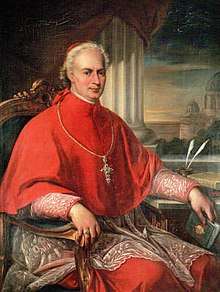Luigi Lambruschini
Luigi Lambruschini (6 March 1776 – 12 May 1854) was an Italian cardinal of the Roman Catholic Church in the mid nineteenth century. He was a member of the Clerics Regular of St. Paul and served in the diplomatic corps of the Holy See.
Luigi Lambruschini | |
|---|---|
| Prefect of the Congregation for Rites | |
 | |
| Church | Roman Catholic Church |
| Appointed | 8 June 1847 |
| Term ended | 12 May 1854 |
| Predecessor | Ludovico Micara |
| Successor | Costantino Patrizi Naro |
| Other posts |
|
| Orders | |
| Ordination | 1 January 1799 by Giovanni Luca Solari |
| Consecration | 3 October 1819 by Giulio Maria della Somaglia |
| Created cardinal | 30 September 1831 by Pope Gregory XVI |
| Rank | Cardinal-Priest (1832–42) Cardinal-Bishop (1842–54) |
| Personal details | |
| Birth name | Emmanuele Niccolò Lambruschini |
| Born | 6 March 1776 Sestri Levante, Kingdom of Sardinia |
| Died | 12 May 1854 (aged 78) Rome, Papal States |
| Buried | San Carlo ai Catinari |
| Parents | Bernardo Lambruschini Pellegrina Raggi |
| Previous post |
|
| Coat of arms |  |
Biography
Early life
The youngest of ten children, he was born at Sestri Levante, then part of the independent Republic of Genoa to Bernardo and Pellegrina Raggi Lambruschini, and baptized Emmanuele Nicolo. His older brother, Giovanni Battista Lambruschini became bishop of the Diocese of Orvieto.[1]
Lambruschini attended a Jesuit school in Santa Margherita Ligure, and then the Oratorio di San Bartolomeo in Bordighera, run by the Order of the Barnabites. He entered the order in 1793, and after a novitiate, pronounced solemn vows in November 1794, taking the name of Luigi.[2] He was then to Macerata for further study, took minor orders in Rome in 1797, and was ordained a priest back home in Sestri Levante in January 1799. He then taught Barnabite seminarians rhetoric, philosophy and mathematics, first in Bologna, then in San Severino Marche and, from May 1801, in Macerata.[1]
Diplomatic career
He attended the Congress of Vienna in 1815 as secretary to Cardinal Ercole Consalvi.[3] As secretary of the Congregation of Extraordinary Ecclesiastical Affairs, he took part in concluding concordats with various states, including Tuscany, Naples, and Bavaria. According to Umberto Benigni, "Next to Consalvi and Pacca, Lambruschini was among the greatest diplomats of the Holy See in the nineteenth century."[3] In 1816, Lambruschini became vice-general of the Barnabite order.[2]
In 1819, Lambruschini was appointed Archbishop of Genoa. It was rumored that his promotion was to be attributed to the desire of Secretary of State Consalvi to remove from Rome a clergyman who, having acquired too much influence on the pope, was now an obstacle to his own plans for government.[1] In 1826, he was named as Apostolic Nuncio to the Kingdom of France by Pope Pius VII, but was forced to flee his diplomatic post following the 1830 revolution that toppled the Bourbon monarchy and brought House of Orleans pretender Louis-Phillippe to the French throne.[3]
He was made a cardinal in 1831, given the titular church of San Callisto on 24 February 1832.[4] For the next four years, Cardinal Lambruschini held various curial posts until in January 1836 he was appointed Secretary of State to Pope Gregory XVI. His appointment was seen as a compromise between those who hoped for reform and the zealanti who wished to see dissent more forcefully suppressed; although it was said that the Cardinal was "liberal chiefly in his employment of spies and prisons".[5]
He was the leading conservative candidate in the 1846 papal conclave. Though he received a majority of the votes initially, it was clear that he could not achieve the required two-thirds majority. He was eventually defeated by the liberal candidate, Giovanni Maria Mastai Ferretti, the Archbishop (personal title) of Imola, who became Pope Pius IX.
Lambruschini was a particularly hated figure among the masonic republicans during the 1848 Revolutions that temporarily deposed Pope Pius IX. His house was ransacked and he was forced to flee for his life, disguised as a stablehand. He returned following the Pope's restoration. He died in Rome on May 12, 1854, Rome and was buried in the Barnabite church of San Carlo ai Catinari, Rome.[2]
He was also the uncle of the Portuguese poet and philosopher, Raul Lambruschini de Sousa Leal.
Works
- A Polemical Treatise on the Immaculate Conception of Mary, 1842[6]
References
- Biographical Dictionary of Italians , 63, pp. 218-223, Institute of the Italian Encyclopedia
- Miranda, Salvador. "Lambruschini, C.R.S.P., Luigi", The Cardinals of the Holy Roman Church, Florida International University
- Benigni, Umberto. "Luigi Lambruschini." The Catholic Encyclopedia Vol. 8. New York: Robert Appleton Company, 1910. 3 January 2019
- Cardinal Title S. Callisto GCatholic.org
- Lease, Gary. “Denunciation as a Tool of Ecclesiastical Control: The Case of Roman Catholic Modernism.” The Journal of Modern History, vol. 68, no. 4, 1996, pp. 819–830 JSTOR, www.jstor.org/stable/2946721
- Lambruschini, Luigi. A Polemical Treatise on the Immaculate Conception of Mary, New York, D.&J. Sadlier & Co., 1855
![]()
Sources
- Manzini, Luigi M. (1960). Il cardinale Luigi Lambruschini (in Italian). Biblioteca apostolica vaticana.
See also
| Catholic Church titles | ||
|---|---|---|
| Preceded by Tommaso Bernetti |
Cardinal Secretary of State 1836–1846 |
Succeeded by Pasquale Tommaso Gizzi |